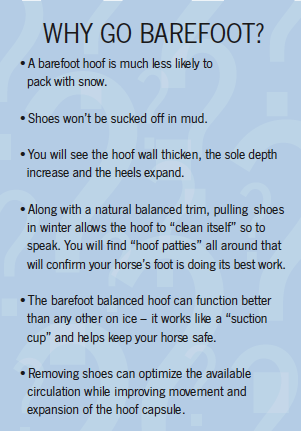Winter poses special challenges to your horse’s feet even though they are constantly adapting to their environment. Let’s look at a “top ten list” of things you can do to ensure your equine companion has healthy hooves.
1. Consider pulling shoes. While I am a big proponent of barefoot horses, I recognize that many still use shoes for a variety of reasons. But whether you have ice and snow or mud and rain, winter is a great time to let your horse go barefoot (see sidebar).
2. Trims remain important. The hoof will likely grow more slowly in winter, but regular daily care and routine trims (no less than every eight weeks, generally) are still crucial. Keeping the balance is critical, as always.
3. Damp, dark conditions make great homes for fungal and bacterial infections. In cold climates, a hard freeze can help, but in chronically damp conditions, daily cleaning and inspection is important. It is also important to keep turnout time up, as standing in stalls can work against your horse when it comes to fungus issues or bacterial infections.
 4. Healthy hooves need moisture. While too much moisture is not good, some moisture is essential. If you live in a cold or wet climate and use wood chips in your stalls, don’t make them deep. They will wick the moisture away from the foot. Remove mud from the lower legs and outside hoof walls; drying mud can cause rot and suck valuable moisture out of the tissues and hooves. If you live in dry conditions, consider letting your water trough overflow so your horse can stand in water as he drinks. If he won’t do this, or if it is not enough, consider soaking boots.
4. Healthy hooves need moisture. While too much moisture is not good, some moisture is essential. If you live in a cold or wet climate and use wood chips in your stalls, don’t make them deep. They will wick the moisture away from the foot. Remove mud from the lower legs and outside hoof walls; drying mud can cause rot and suck valuable moisture out of the tissues and hooves. If you live in dry conditions, consider letting your water trough overflow so your horse can stand in water as he drinks. If he won’t do this, or if it is not enough, consider soaking boots.
5. Winter often means no pastures so you will need to make certain your hay and feed meet your horse’s nutritional requirements. If they are deficient in protein or minerals, your horse will suffer. You may need to add supplements to ensure he is getting all he needs to grow good feet and hair.
6. Daily turnout is critical. Horses need to be outside for many reasons. More and more horse families are converting to 24/7 turnout. Yet it also remains important to give your horse a shelter to escape the elements in snowy or wet climates. A run-in offering dry footing and protection from harsh weather should be available (see page 25 for more on run-ins). Again, if you live in a dry winter area, consider the water bucket area for moisturizing your horse’s hooves.
7. Too much time in a stall is not beneficial for your horse. Constant exposure to urine and manure weakens the hoof walls and adds to the potential for bacterial or fungal infections.
8. Wintering your horse also depends on how you will use him. If you plan to ride, let your farrier know and work with him/her to keep a solid schedule for trims. This will keep everyone safer by keeping the horse’s feet functioning optimally.
9. The winter trim may differ from other trims. For example, your farrier may choose to “roll” the hoof wall for hard or frozen ground. Consult with your farrier about special needs.
10. Finally, no matter what type of winter is typical in your location, you need to be prepared and flexible. Keep tabs on the weather forecast and book your winter trim before extreme weather hits. If you have more snow or rain than usual, or if you see that ice will be more of an issue than normal, be certain to adjust your trims or trim schedule.
Winter often signals the end of riding season, but that doesn’t have to be the case if you are mindful of weather conditions and support healthy hooves. And just think – no flies. We could be on to something here!
Sherri Pennanen is a certified United Horsemanship Horse Groomer who serves Western New York and Southern Ontario. Natural, balanced trims and holistic horse care are the hallmarks of sherri’s farrier business. she has studied under experts such as Pete Ramey, Jim Crew and Dr. Bowker. A certified hoof care specialist, Sherri says one of the best rewards for her work is being told by customers that the horses she trims “play again”. Visit her website at www.betterbebarefoot.com.








